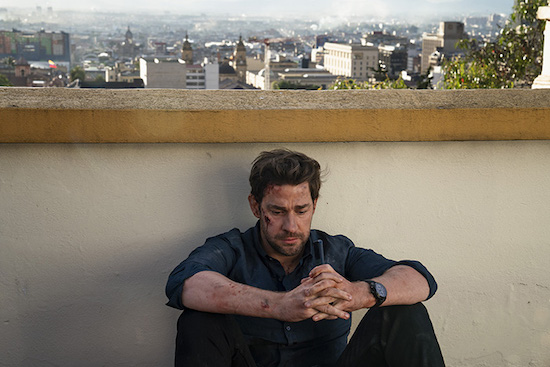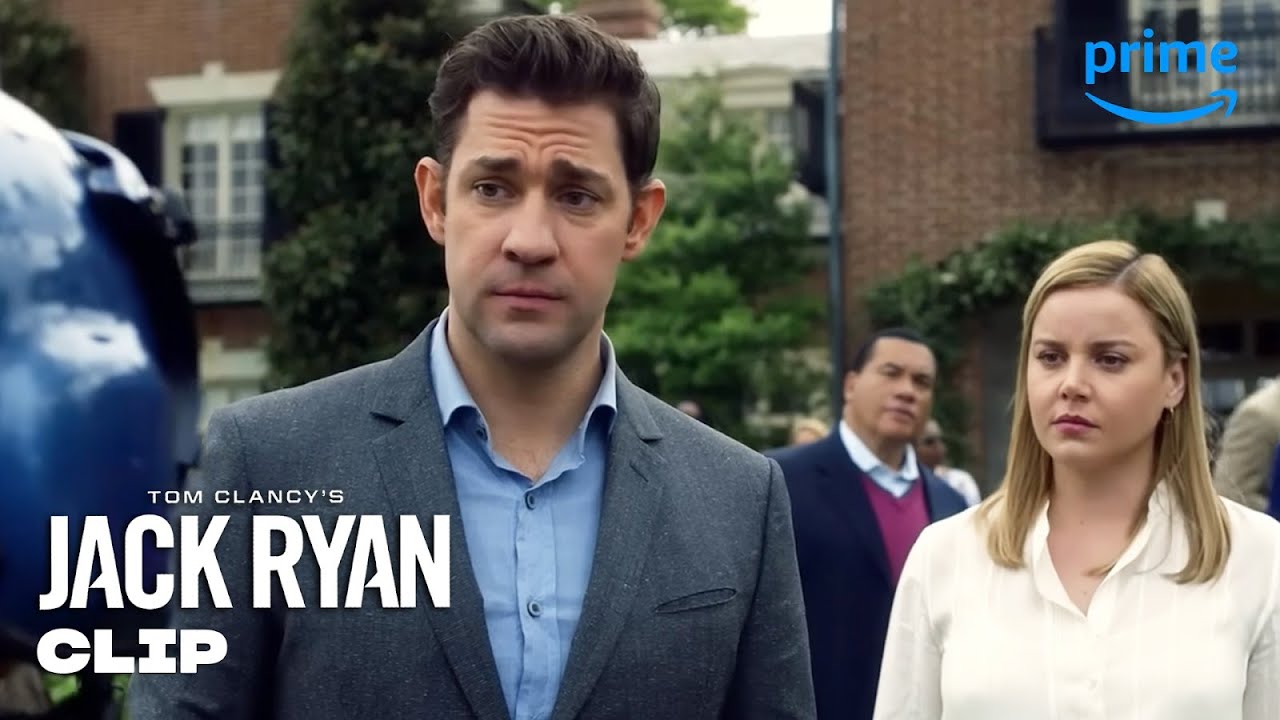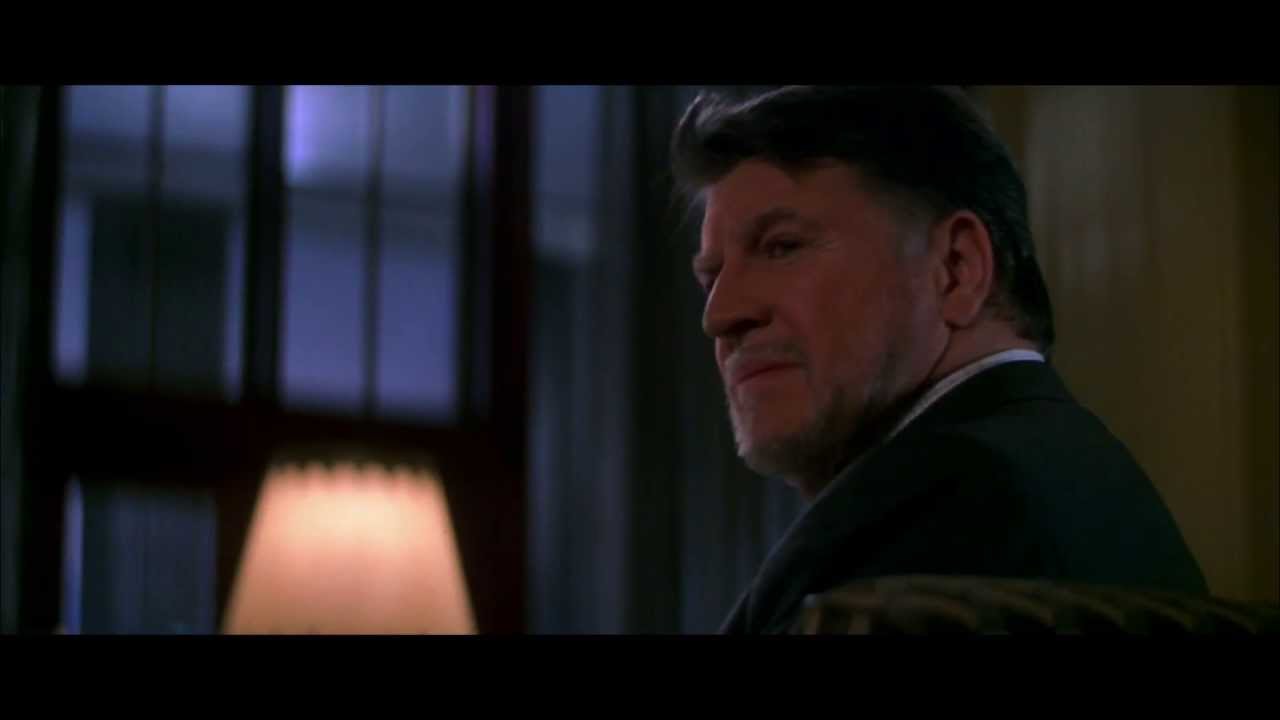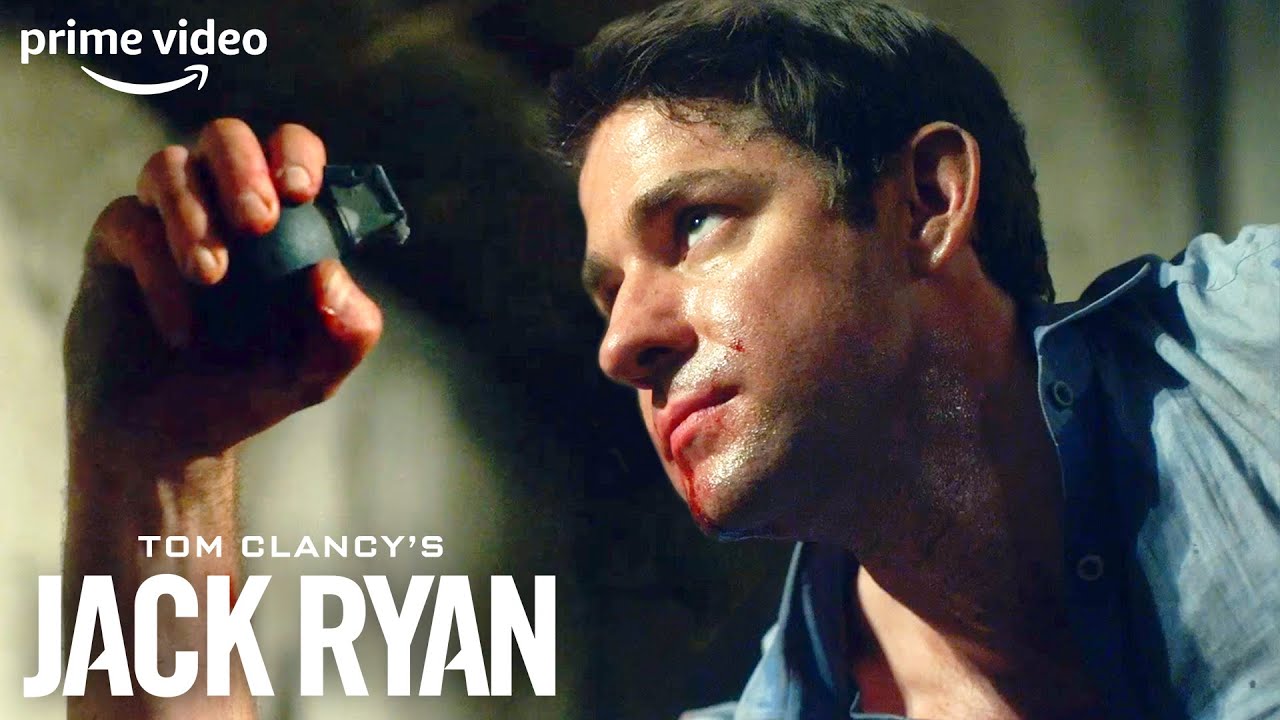It is the most memorable part of the film: a balding creep of an officer has made himself comfortable in the submarine captain’s private quarters. When the captain arrives in his own room, the officer, sitting pretty at a table, takes the liberty to read out loud from a notebook he found. Up to this point, all the dialogue within the submarine has been spoken in Russian and subtitled into English. The officer begins to read, and the camera zooms slowly in to frame a close-up on his mouth. (In Russian, subtitled: ) “…In a place called [then without subtitles] Armageddon [continuing on speaking in English] and the seventh angel poured forth his bowl into the air…” The end of the world is the hinge, the word ‘Armageddon’ being the same in Russian and English; the camera zoom out again, and from that point onwards, no matter the language, the dialogue takes place in English. It is an elegant, intuitive construction, for English-speakers at least; as if you’ve entered into some sort of pact with the film that allows you to understand other languages. (Rather than, say, simply a device that spares us two hours of Sean Connery pretending to speak Russian.)
The Hunt for Red October was released in 1990, based on a book published six years earlier, a thriller for its time: essentially a military procedural drama, of a Soviet captain defecting – along with his billion-dollar baby of a submarine – to the US. It’s a bit of shameless Cold War triumphalism, released when the USSR was still in the process of dissolution, where America and its ideas-men have the freedom to make things happen, while their Soviet counterparts are cowed by relentless double-crossing and backstabbing in the name of the ‘people’; of course, the film chortles, we won. The story’s villains are the Soviet politicians and generals trying to stop the submarines crew from escape, as well as the hard-nosed bureaucrats in Washington DC who didn’t understand the captain’s noble intentions. The only person who does understand, of course, is stockbroker, former marine, and history professor Jack Ryan. He saves the day with empathy, intuition, and a working knowledge of Typhoon-class subaquatic vessels armed with nuclear weapons.
You know Jack Ryan. Whether you’ve encountered him on the big screen, a spirit that has inhabited Alec Baldwin, Harrison Ford, Ben Affleck, Chris Pine; or on the small screen, played by John Krasinki in the ongoing television series; or in the twenty-seven and counting novels in which Ryan has come out of hiding, retirement and worse to re-join the CIA, stop World War 3, or become President of the United States – each of these multiple times. Ryan is one of Tom Clancy’s most enduring creations, perhaps apart from the creation of Tom Clancy himself. “Jack’s a new, improved version of me,” Clancy would shrug in later interviews. “It’s a fact.”
The Hunt for Red October was Ryan’s first outing; the book had been an international best seller, and the film did well in the box office. Navy recruitment tables were set up in the lobbies of dozens of American cinemas, in the hopes of achieving what had become known as the ‘Top Gun effect’, where the Air Force saw a five hundred percent rise in recruitment applications in the months after the film came out in 1986. When the VHS was set to be released, the production company approached the US Department of Defense about an advertising spot preceding the film. They declined, on the advice from a major advertising agency that it would be redundant having a presence in front of what was “already a two-hour recruiting commercial.” No such leap in new Navy cadets was recorded.
But it is apt that the most enduring scene from the film is minor in so many ways: delivered by a character who is killed shortly after, as a scene that by its very nature can’t have been part of the book it was based on. The Hunt for Red October was Tom Clancy’s first book, though he wasn’t involved in the screenplay. And still the moment reflects much of the world that Clancy built over the coming decades: an act of making things intelligible, acting as a self-appointed liaison between the military and realm of popular culture, even in his own absence.
I’ve been returning to Clancy reluctantly recently. Let me be upfront: I have never read any of his books, just seeing them sat on my parents’ shelves growing up, and only seen a small handful of the films. His cultural influence, however and unfortunately, is undeniable. Actually taking the stories in isn’t explicitly necessary: they all tell of American exceptionalism coming up against a world of foes, who are foiled by bravery and the latest covert technology. That his work is blatant right-wing propaganda that has been long been part of the woodwork is one part of it; I find it fascinating that instead of being framed or discussed as political statements, his work instead has managed to merge into the background, as if it a neutral enjoyment to be passively absorbed – just another airport novel to read on holiday, another Hollywood thriller to watch on the plane back. More striking is Clancy’s own self-positioning, as a myopic insurance salesman who rose to national security expert through fiction. Even if never consumed directly, Clancy has become a permanent presence. He passed away in 2013, having authored and co-authored nineteen novels and eleven books of nonfiction, alongside setting out the plots for over forty books that bore his name as part of his fiction franchise, as well as setting up a video game development company. Last year alone saw the release of the film Without Remorse, based on his 1993 book; the third series of Jack Ryan on Prime; and the launch of video game Tom Clancy’s XDefiant; new iterations of the Rainbow Six and Ghost Recon games will be released in the new year (they’re all shooters); meanwhile the ‘post-Clancy’ series of novels continue to release an average of two books a year. His is a world of relentless military manoeuvring, permanent black ops. Like it or not, it is Clancy’s world we are living in.
The editor of Proceedings magazine began getting persistent calls in 1981. An enthusiastic subscriber to the Naval Institute Press’s monthly journal had, he claimed, a letter to the editor that should be printed. They ignored him; he kept calling back. Eventually, they acquiesced, printed the letter, and sent the man a cheque for his contribution. The cheque was never cashed: instead it was framed, and hung on the wall of a study in Calvert County, Maryland, an affluent suburban peninsula just outside of Washington DC, as the first payment for writing the man ever received. The following year, the same man submitted an article for publishing, a detailed technical description of how nuclear missiles might be mounted and launched from a hovercraft. As a venue for the discussion of the US Navy’s tactical and technical possibilities, it was a fit, and the piece was published.
Tom Clancy was an insurance salesman, who had taken over his mother-in-law’s business selling the notion of safety to the occupants of the oversized houses dotting the Chesapeake Bay. “My childhood,” he’d later say, “was Leave it to Beaver in real life, including an older brother named Wally. Looking back on it, it was grossly unremarkable in every detail.” He’d wanted to join the military, attempting to join the reserve training corps while in university, and again after, rejected both times due to poor eyesight. He contented himself instead by revelling in the military’s history and technology, an amateur enthusiast who would pick the brains of his clients, some of whom worked at the nearby Naval training base, others who were former naval officers who worked at the county’s nuclear power plant. The Naval Press had been having discussions about the best means to reach a wider audience, instructing editors to keep an eye out for “good naval fiction” as an experiment. Then in 1983 a parcel was dropped off by hand by their enthusiastic local subscriber, containing the manuscript for The Hunt for Red October. Based loosely on historical incidents, it was designed as pulp, filled with detailed descriptions of the machinery and gadgets at work. The Press decided this was the fiction they had been looking for, going on to publish their first-ever novel. Recently retired from active duty, Captain James Barber took over the press just before the book was to be printed; concerned about potential classified information held within the book, he sent the manuscript off to the Navy’s submarine czar for review. It came back two weeks later with the note: “Some of it is right and some of it is wrong; some of it is classified, and some is not. We see no purpose pointing out which is which.”
The book was published the next year; new to the literary market, the Naval Press heavily promoted the book, focusing on what they knew best – Washington. Sales were mediocre until, as Clancy himself would tell it, a lobbyist got a hold of the book and bought a whole box to give to friends for Christmas, including several ambassadors and the then President, Ronald Reagan. Pictured with the book sitting on his desk in an image accompanying an article in Time magazine, the former actor called it “the perfect yarn”. Sales boomed.
Writing the introduction for The Tom Clancy Companion (1992), Marc Cerasini, author of several novelisations of Star Wars and Godzilla stories, summarises it gushingly: “The Hunt for Red October marks the birth of a genre. In it he fused traditional military fiction with near-future apocalypse science fiction, touches of espionage fiction, and a large dose of social realism to create a brand new type of novel that we shall hereafter call the techno-thriller.” Clancy bristled against the term ‘techno-thriller’ – “a lot of people have made such a big damned deal about the technical stuff,” he complained in a 1984 letter; in later interviews, he’d often make sure to raise the point how detective novels included plenty of factual details on criminal evidence procedures, but they weren’t referred to as “techno-mysteries” – still, the designation stuck.
What followed after was an amazing case of wish-fulfilment and a literary persona bursting into life: the publisher gave the author credibility, while the technical descriptions and terminology gave it verisimilitude. Printed by the Navy’s own press, military figures were given the impression that this was sanctioned and state-supported fiction, verging on nonfiction. Presented with a vision of a gung-ho and righteous armed forces, the creator of this vision was welcomed, and together they walked through the mirror – what started as lunch at the White House, tours of retired battle ships and chances to drive around tanks turned into regular speaking events at the CIA, FBI, and Executive retreats, as well as a seat on the National Space Council. What started as a conga line, with Clancy looking in from afar, desperate to follow along and dance in line, soon turned into an ever-widening circle jerk. “They’re not just novels,” Vice President Dan Quayle stated. “They’re read as the real thing.” He would brandish Clancy’s book Red Storm Rising (1986) on the Senate floor in 1988 as evidence for the need for anti-satellite weaponry; Reagan would soon after urge Margaret Thatcher to read the book in order to get “an excellent picture of the Soviet Union’s intentions and strategy”. The Marine Corps and the Navy have required reading lists that include several of Clancy’s novels. When Pablo Escobar was apprehended in 1993, as Clancy liked to mention, on his bedside stand was a copy of Clear and Present Danger (1989), with all the sections describing electronic surveillance marked out with a highlighter. Slightly closer to the present, in 2003, a secretary for Homeland Defence was asked at a Senate hearing about the risks involved in the remote sensing of large explosives; his response was to summarise the nuclear detonation that takes place in The Sum of All Fears (1991).
There is a rich literary tradition of dragging Clancy; there were humorous hit pieces over the decades in the New Yorker (“It will be pretty clear to readers of The Sum of All Fears that whatever it is Tom Clancy has, success has done nothing to spoil it.”) and the Washington Post (“Clancyland, with its games and gadgets and guns, fulfilled the need of a pre-pubescent male.”). Early attempts at critical counters to his work were fielded: Loudon Wainwright, writing in Life magazine in 1985, pinned Hunt for Red October as a fantasy as “close to an act of propaganda and caricature as those scores of Happy Yank films Hollywood turned out during World War II.” Journalist Scott Shuger made a vocal enemy of Clancy after writing in 1989, “Learning how war works from Tom Clancy books is like learning how the law works by watching L.A. Law.” None of this commentary, of course, deterred the sales and reach of his work. What’s of interest here isn’t literary merit, of course. As Andrew Lanham noted recently in the New Republic, reviewing the first two seasons of Jack Ryan, “the repetitive, easy banality of the story is precisely the point: It desensitizes us. It tells us that this is just what we do.” More to the point is how propaganda gains a purchase on reality, how it fragments, spreads, and seeps into the water supply.
Just under a month after coalition forces had pushed the Iraqi army out of Kuwait in February 1991, French theorist Jean Baudrillard penned an article with the deliberately provocative title, ‘The Gulf War Did Not Take Place.’ His point was not to deny what had happened on the ground, but in how it marked a shift in how conflict was perceived, disseminated and consumed. The Gulf War had embedded reporters, with CNN broadcasting live daily from front lines, turning war into a televised spectacle that could be viewed from afar. This new distant commodity became a sort of unreal shadow play, where the spectacle of conflict was used to try and convince those at home they were engaged in a war with purpose, what Baudrillard called an “unfrozen cold war”.
Such a perspective on war fragmented and zoomed in further ten years later, when film and TV producer Jerry Bruckheimer (then of Top Gun and Crime Scene Investigation fame, just fresh from releasing Black Hawk Down) pitched an idea to the Entertainment Media Unit at the Pentagon – war reality TV. The show had originally been the brainchild of Torie Clarke, who as Donald Rumsfeld’s assistant during the Gulf War had engineered the embedded news reporting system. Profiles from the Front Line followed American troops in Afghanistan, marking a shift in how imagery of conflict would reach audiences, as something heavily mediated and entertainment oriented. Since the 1920s, films and television have made use of military equipment, affordable access to war machines being provided in exchange for the approval of the plot and script. The aim, for military organisations, was to reinforce positive public opinion of their work and bolster recruitment. This was the onset of a different order, where the military could create and disseminate their own imagery and narratives. In his book Militainment, Inc. (2010), Roger Stahl charts the increasingly intense collaboration between parts of the entertainment industry and the Pentagon that has led towards a “crystallisation of platforms that invite one to project oneself onto the action.” The contemporary war is diffuse, and interactive. What this creates, Stahl contends, is a shift in the construction of the citizen subject – a shift away from active involvement in civic decisions, an attempt to “deactivate the political subject.”
Of course, by 2001 the Department of Defense was already using the game Rainbow Six: Rogue Spear to instruct operatives how to manoeuvre in city settings. Clancy’s work across print, screen and gaming, is a firm armature of this scene and no small contributor to a state of being where games like Full Spectrum Warrior are used for recruitment, training and maintaining soldier readiness; where the television series Homeland is a firm CIA operative favourite. Clancy could be considered of a piece with Bruckheimer (and his progeny like Michael Bay and Tom Cruise), and other peddlers of military spectacle. But he’s more like a disembodied, multi-media 21st century Henry Kissinger, manipulating US policy through a wide range of manipulations. In many ways, he has more in common with fictional figures like Tom Ripley or Jay Gatsby, as one of the great white pretenders to fake it ‘til you make it, the wistful longings of a suburban boy made Republican hero.
Interviews with Clancy are remarkable in their rhythms and repetitions. Name-dropping exchanges with CIA Director of Public Affairs William Baker, friends who used to be in the secret service, hanging out with four-star general Colin Powell, and on and on. Every mention of military personnel includes a litany of comments on how intelligent and insightful they are; while mentions of politicians and journalists bear a corresponding emphasis on how little they understand. Clancy professes a severe lack of memory for people’s names, unless, that is, it’s an aircraft carrier or that person happens to have a well-decorated uniform. Anecdotes are delivered like well-rehearsed lines, because they have been trotted out reliably like show dogs for each appearance; “first time in the Oval Office,” a favourite, “I tell people it’s like seeing god, except the angels carry guns.”
Most notable, though, is the subject matter of his numerous talks and interviews. His craft, the writing itself, forms a scant part of any of it; asked about his working process, his ideas, or methods, he is reticent, reserved. Why was Red October so successful? “Maybe it’s just a good book, what do you expect me to say?” What’s your writing schedule? “I just get up and go to work, same as anybody else.” But when asked about military and foreign policy issues – as he was the majority of the time – he is expansive, opinionated, overflowing. Are we being aggressive enough in our foreign policy? Who is the next credible superpower antithetical to the US? What do you think the world needs? “More freedom, more democracy, more capitalism.”
Secondary to commenting on current affairs are questions on the veracity of his writing, and how his plots touch on actual events; the precision of his obsession with weaponry and new forms of technology bringing with it the illusion of illicit insight. Despite persistent boasts about who he knows, Clancy was coy with where he got his facts, stressing vaguely that it’s all out there in books if you know where to look, repeating lines that don’t feel at all lawyer-fed: “All my information comes from open sources and from conversations with people who don’t want to break the law. If you give away secret information you’re committing a federal felony and going to prison is not fun so these people don’t do that.’ In one C-SPAN interview from 2003, he is asked several times if he has ever influenced the government or the military. “It’s not my job to tell the President or the Secretary of Defence how to do their job,” he says. “The military’s a very introspective organisation,” he adds later. “It’s very good at looking at itself; where America has frequently failed is how we look at the military.”
The impression often given is that Clancy’s main role was as public-facing spokesperson, shifting opinions through page-turners. Voters would be more sympathetic to such activities if primed by savvy family man Jack Ryan, and bestseller status could be interpreted as tacit endorsement of strong tactics; as a 1988 Newsweek piece, put it, Clancy was “the authorised winked-at way to leak information that will help the military procurement budget.” But the question now – as we find ourselves decades into dispersed eternal militarised states of living, war is in the water and the air, already paid for by your subscription service and as your weekend ‘me time’ – is who, as Dan Quayle trilled, read it as the ‘real thing’. When asked on C-SPAN about the proximity of the events of September 11th to what occurs in his book Debt of Honour (1993), Clancy is quick to roll out a reply, but one that contradicts his earlier denials. “I have no reason to believe any of the bad guys ever read that book – oh by the way the purpose of the book when I wrote Debt of Honour was to warn the government that something like that is possible, in fact I personally told the head officer for Continental Air Defence about this possibility back in 1988, so at least I gave them fair warning,” grimacing and throwing up his hands. Cerasini, later in the Clancy Companion makes the point, perhaps inadvertently, of who Clancy was actually writing to:
‘Clancy’s reversal of the trend, so fashionable in the media, in popular culture, and among the intelligentsia, of bashing the ‘military industrial complex’ and the intelligence agencies is a big factor in his appeal. Besides the obvious point that many, many Americans work in these areas who may not like being blamed for the ills of the world, we must remember that we need our military.’
It would seem that the many, many Americans who work in these areas, and the generals he chums around with, are, in fact, the true audience of his oeuvre. Historian Walter Hixson, in a 1993 article, described how Clancy helped instigate a “cult of national security”, promoting “ideologically constructed perceptions of foreign policy discourse – perceptions that were absorbed by millions of Americans and were actively promoted by a national security establishment whose interests they served.” What seems apparent over twenty years later is that these perceptions weren’t so much ‘promoted’ by the national security establishment so much as subscribed to and absorbed with a steadfast devotion. Part of the reason that Clancy is one of the architects of our dark era isn’t because he sold a lot of books to people, but because a small subset of those people, who happened to have their fingers on buttons, triggers and order-delivering keyboards, believed in the persona that Clancy projected of military savant. Even in death, the persona continues.
In Necropolitics (2019), political philosopher Achille Mbembe describes the “nocturnal body” of democracy – the neglected aspects of slavery, colonialism and subjected violence – that enabled the “solar body”, the image which democracy presented to itself, to exist and to function. Tracing its developments through the ages, he describes the existence of the contemporary “war machine”, a new independent entity that is separate from a state army, that has “the features of a political organization and a mercantile company,” that asserts control in myriad ways, only one of which is manifest in violence. I would posit the undead entity of Tom Clancy in all its various forms as a war machine, where acts of propaganda, cultural consumption, and militarised subjecthood are all one. Tom Clancy’s sprawling fantasy we inhabit is the erasure of politics, a terrain of endless reruns and remakes of hollow aggressions, and the true face of Western democracy, cloaked in night vision goggles, silently pointing some indescribable weapon at your head.






